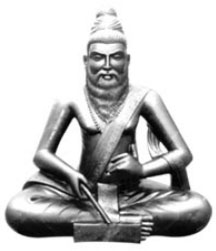![]()
(The author an eminent guru and Founder – Director of the Kuchipudi Art Academy, Madras is acclaimed by all art lovers, including his contemporaries, as the person who has with single-minded devotion and effort ensured international recognition for Kuchipudi dance.)
The name Kuchipudi denotes both the dance style that has come to prominence since the 50s and the tiny, remote village where it was born. Kuchipudi, little known outside a few villages skirting it, has no come to occupy a very significant place on the dance map of India, though it has yet to acquire the prestige and acceptability it fully deserves. Situated in the Krishna district of Andhra Pradesh, it is 32 miles from Vijayawada.
Its particular location proved very fortunate for its people and its art.
Kuchipudi has a great history. Six miles away from it lies Srikakulam, the ancient capital of the Satavahana empire (2nd century BC). The rulers of the Satavahana dynasty were great patrons of art. From the inscriptions found here, on the temples of Andhra Vishnu, which was the most sacred shrine of those days, it is evident that no fewer than 300 devadasis consecrated to the deity, received royal patronage. The sculptures excavated in this area have crystallized into stone the effulgent grace of those women whose dance was an act of worship.
As any other art form, dance also enjoyed the patronage of rulers prior to the advent of Kuchipudi style in its present accent, because of the prevalence of the devadasi system. In course of time, unfortunately devadasis became the victims feudal abuse.
In later years, Buddhism flourished at two particularly prominent centers. Nagarjuna, the great exponent of Mahayana school, liver near Kuchipudi during his early years. Ghantasala, another place five miles away, was a great Buddhist pilgrim centre from the 2nd century AD to the 14th century. It was prosperous port too; tempting traders from far away countries till the Krishna River changed her course.
Movva, the birthplace of Kshetrajana, the great composer of devotional Padams, is about two miles away from Kuchipudi. From all this can be surmised that the location of the Kuchipudi village has been, over a long period spanning twenty centuries, historically as well as culturally most important with a halo around it. The whole vicinity of Kuchipudi was filled with flavors of art.
| As empires rose and fell in the Andhra territory, religions also shared their fate. The Satavahana Empire declined and with it the Vedic religion that the rulers practiced received a setback. Buddhism rose to greater importance and held way till about the 4th century AD. That is till it was replaced by Janinism under the Easter Chalukyas. In order to propagate their religion, these Jain rulers exploited all the available dance forms patronizing liberally both the classical and MARGI style of devadasis- some of the whom by then had degenerated into Rajanartakis or court-dancer and folk or DESI style rooted in the soil.
The Chalukyas gave away to the Kakatiyas of Waranagal by about the 12th century. Originally Jains, the Kakaitya rulers took to the Pasupata Virasaiv cult under the influence of Basava. In 1230 AD a powerful ruler of the Kakatiyas, Kakati Ganapati |
Deva, invaded divi and subjugate the ruler, Jayappa of the Ayya dynasty and later appointed him commander of his own elephant corps. An ardent lover of dance in all its many slandered forms, Jayappa wrote and excellent treaties on the subject, entitled Nritta Ratnavali.
The Kakatiya rulers, being followers of the Virsaiva cult, used the local dance forms to spread their own religion. Palkuriki Somanatha an eminent poet of the Kakatiya court listed all these dance forms in his book, Pandittaradhyacharitra, in Telugu.
The Muslim ruler Mohammed bin Tughlak, invaded Warangal and humbled the Kakatiyas. In course of time, Viranarasimha III, ruler of neighboring kingdom of Kalinga, annexed the region around Srikakulam and renovated the Andhra



